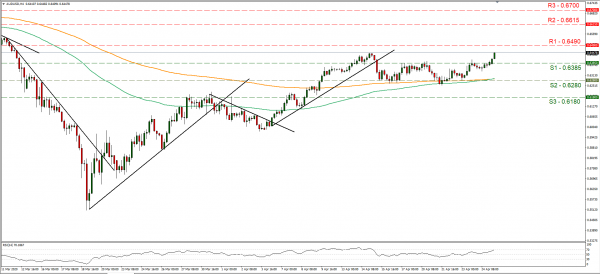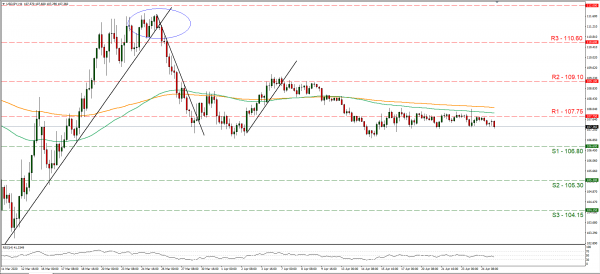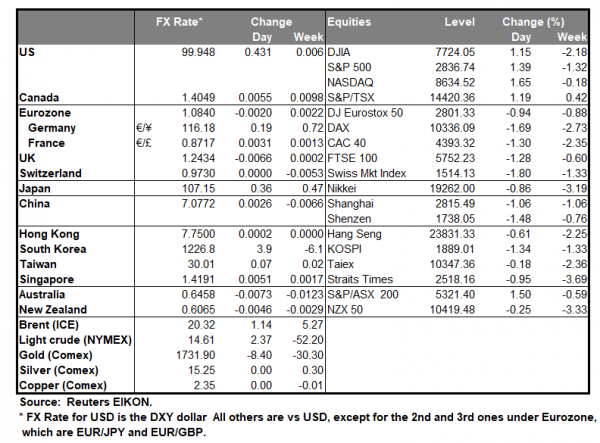The Aussie gained against the USD on Friday and during the Asian session today as hopes for reopening the global economy strengthened. In US and Europe, national governments are taking measures to ease some of lockdown restrictions in place, but the markets seem to remain wary because the virus is still ever present in everyday life. Hence the main issue with easing the lockdowns and restarting the global economy remains the lack of any coordination, while at the same time it must not cause a substantial increase of the infection rate for COVID 19. It was characteristic of the Australian currency that it tended to weaken on Friday as the first clinical trials for a COVID 19 medicine failed. Also, the anticipation of more Chinese businesses coming back to work tends to support the Aussie as a substantial amount of Australian exports is heading there, while at the same time the China’s PMIs for April along with Australia’s CPI rates for Q1 could move the AUD. We tend to view the situation as positive yet fragile, hence we maintain a hesitant bullish outlook for AUD. AUD/USD rose on Friday and during today’s Asian session breaking the 0.6385 (S1) resistance line, now turned to support. We maintain a bullish outlook, as the RSI indicator below our 4-hour chart tends to confirm the dominance of the bulls, yet at the same time may be also showing that the pair’s long position may be overcrowded. Should the bulls maintain control over the pair’s direction we could see it breaking the 0.6490 (R1) line and aim for the 0.6615 (R2) hurdle. If the bears take over, we the could pair break the 0.6385 (S1) line and aim for the 0.6280 (S2) barrier, which contained the pair’s drop on the 16th and 21st of the month.
BoJ’s Interest rate decision comes out early
During the Asian session we got BoJ’s interest rate decision a bit earlier as the decision was expected to be released during tomorrow’s Asian session. The bank remained on hold as expected at -0.10% and the market’s attention turned to the accompanying statement and any additional measures of the bank. The Yen seems to remain steady, as the Bank of Japan removed limits on its government bond purchases and increased corporate debt buying to help companies hit by the coronavirus crisis. It was characteristic that on Tuesday the bank had stated that should the coronavirus pandemic be prolonged it could trigger a negative feedback loop in which a worsening economy threatens to destabilize Japan’s financial system, issuing practically a strong warning. Japan’s economy minister stated that the Japanese government and BOJ are to strengthen the policy mix and that they will continue to work closely together. We could see JPY returning to the usual safe haven flow influences, yet further easing could weaken it. USD/JPY maintained its sideways movement just below the 107.75 (R1) resistance line. We tend to maintain the same outlook for the pair in the short term. Should the pair’s long positions be favoured by the market, we could see it breaking the 107.75 (R1) resistance line and aim for the 109.10 (R2) level. Should the pair come under the selling interest of the market we could see it breaking the 106.80 (S1) line aiming lower.
Other economic highlights today and early tomorrow
On a slow Monday, no major financial releases expected.
As for the rest of week
On Tuesday, from Sweden we get Riksbank’s interest rate decision as well as the US consumer sentiment indicator. On Wednesday, Australia’s CPI rates for Q1 are to be released along with Eurozone’s economic sentiment for April, industrial sentiment for April, Germany’s preliminary HICP for April, the preliminary US GDP rates for Q1 and later the Fed’s interest rate decision. On a busy Thursday, Japan’s industrial output for March, China’s NBS PMI’s for April, France’s CPI for April and GDP rates for Q1 ECB’s interest rate decision, the US initial jobless claims and Canada’s GDP rates for February are to be released. On Friday, we get Canada’s Markit Mfg PMI for April and the US ISM Mfg PMI for April.
Support: 0.6385 (S1), 0.6280 (S2), 0.6180 (S3)
Resistance: 0.6490 (R1), 0.6615 (R2), 0.6700 (R3)
Support: 106.30 (S1), 105.30 (S2), 104.15 (S3)
Resistance: 107.75 (R1), 109.10 (R2), 110.60 (R3)
















